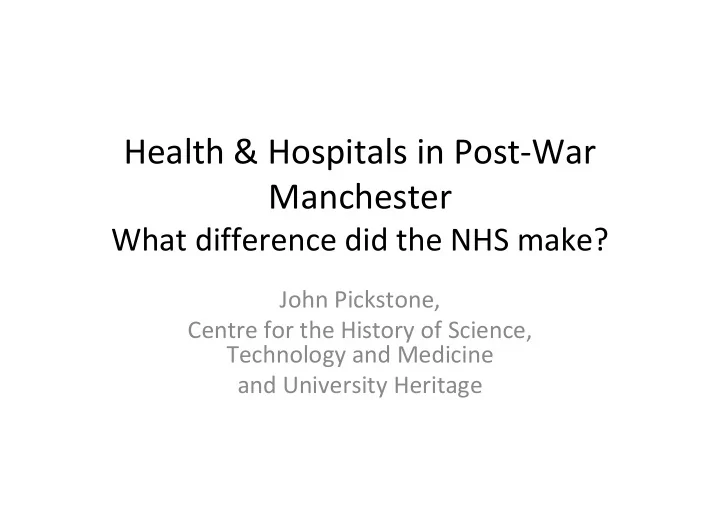

Health & Hospitals in Post-War Manchester What difference did the NHS make? John Pickstone, Centre for the History of Science, Technology and Medicine and University Heritage
Framing my topic • NHS introduced 1948; nationalised hospitals • Planned through WWII – visions for post-war • Re-planned by BEVAN under Labour, Act 1946 • No general scheme of Hospital building until 1962 National Plan. Contrast housing & education • So, what was done, and how did that correspond to interwar and WWII plans? • Esp re Manchester
Interwar planing • DAWSON report, 1920, based on local Health Centres – rather like cottage hospitals • His father was a architect – thus:
Ground Floor. Examination rooms and consulting room for Clinical and Communal Patients. Child Welfare. Minor operations and dentistry. Laboratory. X-ray and dark room. First Floor. A hospital for 16 beds for both sexes. A small minor operation or Labour room. Second Floor. Residential accommodation for Matrons and Nurses. Kitchen and mess accommodation for Nurses and Staff.
Manchester hospitals in 1938 • VOLUNTARY Sector: Manchester Royal Infirmary etc (teaching), and many smaller hospitals, eg Ancoats • Little new Vol sector building:Christie; PPH at MRI • Big Local Authority hospitals, Withington and Crumpsall; and LA children’s hospital (Booth Hall) • Big infectious disease hospital, Monsall • Mcr TB hospital, Baguley
Christie, New hospital, c 1930 (also becomes in effect a regional cancer service centre )
General worries and Mcr initiatives • Relation of impoverished, but high status voluntary hospitals, • with expanding LA hospital services --without much new bldg; Upgrading • friction in London • Mcr (& Salford) Joint Hospitals Advisory Board , Vol. hospitals, LAs, and University (JSB Stopford) • MSJHAB planned hospital developments, eg new specialist services in LA hospitals; • Inc concrete orthopaedics bldg at MRI (Platt). • MSJHAB seen as national model for joint planning
Harry Platt, orthopaedic surgeon, planning central hospitals
A brief history of NHS war • Part of many plans for post-war Britain, under Coalition govt; much enthusiasm; focuses on hospitals which are now state funded by EMS (and relatively empty) • Initial plans based on Local Authorities; but many were ‘too small’ to run modern hospitals; federate? 1944 Act • Act much disliked by voluntary hospitals and top docs; and by GPs worried re LA ( health centre) takeover. • Tories , 1945, would have maintained existing ownership, with funds for voluntary hospital through Joint Planning Boards.
Bevan and Labour • Labour traditionally on side of LAs • Bevan, NOT from LA background was technocatic, got on well with ‘public spirited’ consultants and leading MOsH (Nuffield) • Solved ownership prob by nationalising vol and LA hospitals. • And expertise problem by Regional Boards in medical school cities, with hospital management committees in towns • LAs keep public health; • Universalises GP coverage but backs off re Health centres etc
New service • Very popular; but building hospitals was NOT a national priority til 1960s • GPs howled, gained much, changed little • Hosp docs – had worried about socialist med; • but in fact, docs were in charge. • MRHB chaired by Stopford, etc • Services Upgraded with new consultants, new services esp in ex LA hospitals; + dentistry etc • Limited gains from rationalisation of services within districts
Unplanned for, daily Issues • Tripartite problematic, esp on municipal sites, now partly LA welfare, partly NHS hospitals • and re fractured ex LA services, eg TB and maternity (both seen to need more beds) • Substantially weakened Local government
Building hospitals for Mcr?: • LA health centres had been planned, but abandoned • Complete University Medical Centre ‘Island site’ • approved by MSJHAB and zoned by Planning authority, in 1945 Mcr plan • 70 acres, next to Education campus, • in 1945 hospital reports - but in fact no major bldg till late 1960s
What was built in Mcr Region? • (Leighton Hospital near Crewe, as specimen prefabricated hospital by Poulson) • Wythenshawe Hospital • Baguley TB sanatorium (near Manchester’s major housing scheme, Wythenshawe). • Scheme for new hospital in 1930s plans • Baguley expanded in WWII, with huts, as EMS hospital, inc plastic surgery centre.
Baguley Hospital and EMS huts, 1947
Why and how was it built? • Hospital in Ministry plan, 1955, for c 500 beds • Green-field site and supported by Manchester city – for rapidly growing estate population • And by Tories in nearby Altrincham – also expanding • Wonderful quarrel about whether it should be ‘smoke free’. Scaled down to 350 beds and keep the huts • Maternity hosp 1965; developed specialist chest services; and general hospital services
1962 Hospital Plan • Enoch Powell – to end asylums, and develop new hospitals. • New hosp planned for Preston but generally • MRHB had incremental schemes, usually on ex municipal sites ( more room) • Maternity services first (public pressure, and ‘always sure of births’) • Inc St Mary’s maternity block (expected in 1945) opened 1970 – now pulled down • Central Mcr hospitals not prioritised • New hosp buildings open c 1992; massive PFI scheme approved 1997; fifty years after first ‘plans ’
Conclusions • NHS major advance and hugely popular, but did not translate into new hospital buildings – except where new populations. • 1962 Plan: bldg incremental and often delayed • Mcr Teaching hospital ‘devolved’ from c 1970 to include Withington/Wythenshawe & Hope Hospital (Salford) • ie Major constructions, ex-municipal sites, edges of city • then in 2000s PFI for central hospitals inc children
What in fact happened • General practice remained a form of small- business, with NI covering only workers • Little Vol Sector hospital bldg (re 1870-1914) – Christie 1930, B’pool, • MRI: PPH & Orthopaedic • Major expansions of Local Authority Services re TB, children, maternity, and housing (under MoH) • LAs take over welfare services after Poor Law ended by 1929 act • Large LAs develop workhouse infirmaries as municipal hospitals, with more acute services
Recommend
More recommend